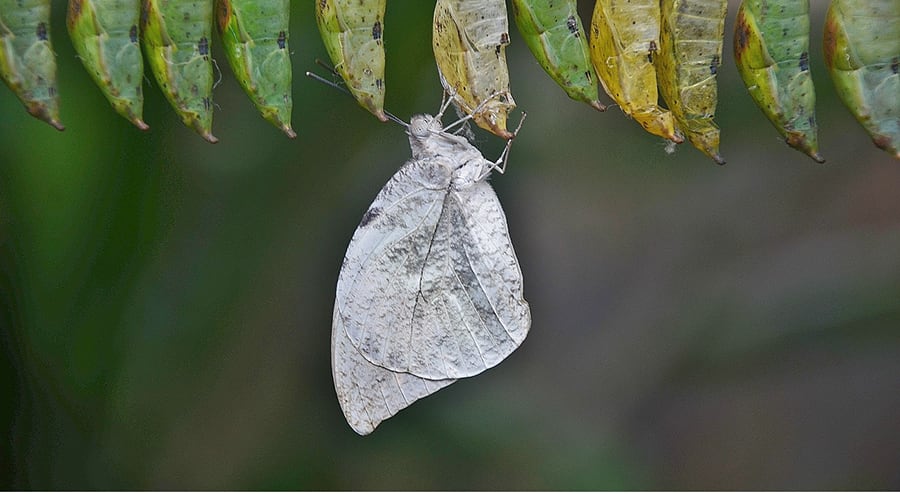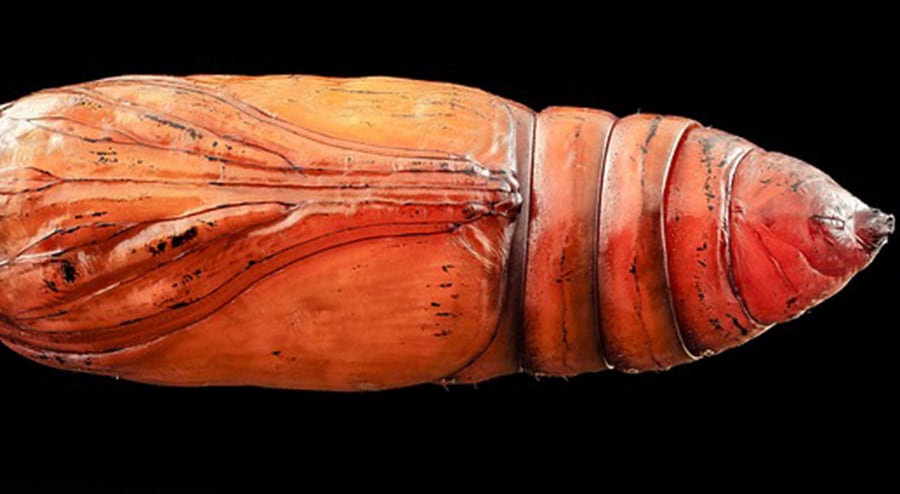Read and Learn More About Pests
How to Exterminate Moth Larvae EffectivelyIf you have a closet full of wool sweaters, clothes, and a home littered with woolen household items, then there is a good chance that the last thing you want to see is a hole in any one of those items. Moths and moth larvae, unfortunately, do not share the sentiment you hold for these items.
These creatures will pepper your woolen items with holes without thinking twice about it and they won’t apologize for it either. It is, therefore, up to you to find ways to keep moth larvae from getting inside your home and making a meal of your clothes—literally.
However, as practical and prudent as that sounds, most homeowners don’t even know that they have a moth problem until they lose their furs and silks to these insects. The best thing you can do, therefore, is NOT to try and eradicate moths from your home, but to try your best to keep them from entering it in the first place.
In this article, we are going to look at ways to keep moths from getting into your home as well as ways through which you can get rid of them once you realize they already are inside the house.
How to Spot A Moth Larvae Infestation
 There are about 11,000 different species of moths in the United States. All of which can be very destructive to your precious fur, silk, and woolen garments. However, the most common type of moth larvae typically found in our homes are either:
There are about 11,000 different species of moths in the United States. All of which can be very destructive to your precious fur, silk, and woolen garments. However, the most common type of moth larvae typically found in our homes are either:
- Clothes moths
- Carpet moths
- Food moths
If you see a moth flying around, then you should get a little worried, though you don’t need to panic. Not because of the moth that is flying around, but because of what it may have deposited in the dark corners within your home. Adult moths do not have mouths, so they will not eat away at your clothes.
It is the moth larvae, or caterpillars, that you should be worried about at all times and may have to resort to pest control. This video gives you a good idea of what to look for when inspecting your home for a moth larvae infestation:
Because these larvae are typically very small in size, it is very easy to miss an infestation. In fact, it is only once you start seeing holes in your garments that you begin to realize that you may have a moth problem. One of the most tell-tale signs of a possible moth infestation is seeing an adult moth flying around.
Once you see one of these insects in your home, then it would be best to start taking a closer look at warm, dark spaces where they like to lay their eggs (larvae). Start by investigating:
- Wardrobes
- Drawers
- Closets
- Skirting boards
In fact, you should make a point of inspecting anywhere within your home where you store pieces of clothes, particularly the dark corners of these areas. As it turns out, moth larvae are an equal opportunity fabric destroyer. They will eat your garments wherever they can find them.
How to Get Rid of A Moth Larvae Infestation
If you don’t have a moth larvae infestation in your home yet, then you should be thanking your lucky stars as this tweet would attest:
Count your blessings every day you are not having to eradicate a clothes moth infestation from a home
— Albenezer Scroogle Drive 🧂🏴☠️🧰 (@alicebemusing) October 7, 2017
Granted, these little insects aren’t as in your face as other pests, but believe it when we say the damage they can cause is substantial. That is why you need to learn how to get rid of them as soon as you spot the makings of an infestation. Here are some practical tips that you can put to good use:
Clean out your closets: Because moths like to lay their eggs in dark, warm places, the first step should be to clean out your closet and any other dark and warm place that hold clothes. Take out all your clothes and vacuum the drawers and entire closet. Make sure that you get into those dark corners by dowsing them with a detergent soaked washcloth to kill off any moth larvae that might have already made them a comfortable home.
Clean your clothes: Once you have cleaned out your closets, the next step is to make sure that your clothes are clean before putting them back. You can either thoroughly wash them, or if they are already clean, then you can put them in Ziploc bags and then place them in your freezer for about 48 hours. These freezing temperatures will kill off any surviving larvae.
Throw out any old cloth items: The less untidy and congested your closet is the less likely it will play host to moth larvae. Try to give away or throw out any old clothes that you are no longer using.
Buy cedar hangers: Moths do not like cedar. In fact, it is a good way to kill off their larvae and keep them off your clothes. Invest in a few cedar hangers before you put your clothes back into the closet.
Lower the heat in your home: Because moths like WARM dark places, you can try taking away one of those elements by lowering the heat in your home or at the very least limiting the number of hours during which the air conditioner is set on high to discourage moths from laying their eggs in your closets.
Use lavender bags: In addition to cedar, moths are not particularly fond of lavender. You can, therefore, place lavender bags in your closet spaces to discourage them from laying their eggs or living in them.
While these methods are quite useful when it comes to eliminating moth larvae infestations, the best defense against these insects is prevention.
How to Moth-Proof Your Home

The first and most important tactic you have for moth-proofing your home is vigilance. You need to be constantly on the lookout for signs of a moth infestation. As mentioned earlier, moth larvae are not exactly going to be nipping at your toes or flying in your face.
They will silently sit in their dark corners in your closet and eat away at your clothes. It is, therefore, up to you to keep looking just to make sure that you do not have an infestation growing without your knowledge.
Other methods of moth-proofing your home include:
Making sure you do not bring them into your home: If you are a fan of antiques and vintage furniture, then you should always double check anything you bring into your home. The same principle applies to bedbugs. Thoroughly clean any vintage clothing or furniture you bring into your home.
Vacuum frequently: Making sure that your home is generally clean and well-kept is a good way to keep moths and any other pests at bay. By cleaning and vacuuming your carpet frequently you could very well get rid of moth larvae without even knowing it.
Thoroughly wash any clothes that you intend to store away: Perspiration remnants and food spills are all good sources food for moth larvae. Make sure that you thoroughly clean and iron any pieces of clothing that you intend to store away.
Practice smart storage: Unfortunately, no matter how clean you keep your clothes and closets, the odd moth might still find its way in there and that is all it takes to start a full-fledged infestation. To keep them from chewing away at your stored clothes, you can keep them in Ziploc bags and clean cotton. This keeps your clothes from condensation as well as out of reach for the moths.
You could also ensure that you use detergents every time you wash your clothes or home to kill off the odd egg that might have otherwise survived all the above tactics.
Hire A Pest Management Professional
If you feel like all this is a fuss, and to some extent it is, then the best course of action is to hire a pest management professional. In fact, this is probably your best course of action because:
- A professional will run a full inspection on your home and tell you all the current and possible pest infestations that you might be inadvertently attracting.
- A professional will give you a comprehensive treatment method that will not only eliminate your current moth problem but also keep your home moth free for a long time after.
- A professional will show you what you need to know and do to prevent any future infestations from occurring.
When most people hear that they need to call a professional pest controller, they immediately picture a yellow tent covering their homes and see themselves spending days at a hotel because their homes will be full of poison for days. The truth is that, when it comes to a moth infestation, the full treatment takes a single visit.
Therefore, it is not something that will cost you an arm and a leg or a lot of time. We are a professional pest management outfit that specializes in ridding your home of any kind of pest infestation including moth larvae. Give us a call today and let us help you keep your home clean and moth free.
https://www.si.edu/spotlight/buginfo/moths
https://www.getridofthings.com/pests/bugs/get-rid-of-moths/
https://www.rentokil.co.uk/moths/how-to-get-rid-of-moths/
https://www.huffingtonpost.com/2012/05/24/get-rid-of-moth_n_1542770.htmlhttps://www.wikihow.com/Get-Rid-of-Moth-Worms
https://www.todayshomeowner.com/how-to-get-rid-of-pantry-moths-and-larvae-in-yo…
More Pest Control Solutions
Read Reviews
Read reviews by other customers like you.
Research
Tips and articles to help you select a pest control provider.
Find Providers
Find a qualified pest control provider in your area.

